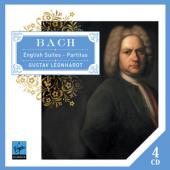Bach: English Suites & Partitas / Leonhardt
 | Label: VIRGIN Catalog: 5099908341723 Format: CD Gustav,Leonhardt/Bach:English & PartitasAllemande, courante, sarabande and gigue form the basis of the dance suite, and Bach followed this format in almost all his instrumental suites, most of which were composed between 1717 and 1723, during his stay in Cöthen as director of music at the court. Bach left us three sets of suites for harpsichord, the French Suites, English Suites and Partitas: the English Suites, which he called simply “Suites with prelude”, were the earliest. There has been much debate about the origin of this term “English” Suites, and many hypotheses have been put forward on the subject. Johann Nikolaus Forkel, Bach’s first biographer, averred that they were written to a commission from a rich Englishman. Whatever the case, unlike the French Suites, which are shorter and contain many French elements, the English Suites have nothing about them which is really English, their stylistic characteristics betraying more obviously French and Italian influences. Bach here does not depart from the strict pattern of the dance suite, but by opening each of the English Suites (as also the Partitas) with a vast prelude, and by broadening the plan of his pieces increasingly between the first and sixth suites, he shows unprecedented ambition for his era. The preludes to the English Suites are vast, concerto-style movements which recall in a way the Italian Concerto and the keyboard transcriptions that Bach made of violin concertos by Vivaldi and other Italian masters. In the Prelude to the Suite No.1, which combines toccata and gigue, he takes his cue from a gigue by Charles Dieupart, a French composer whose harpsichord works he had copied out and who was based in London (which some think might explain the title “English” Suites). In these English Suites a solemn, expressive allemande precedes a courante in the French manner, and then, between a profound sarabande and a sprightly, jolly gigue, Bach inserts dances of various types, introducing a lighter note within the strict framework of the suite. Bach himself was in charge of the publication of his six keyboard Partitas between 1726 and 1731, in which year brought out the complete set as his Opus 1, with a subtitle, Clavier-Übung (“Keyboard exercises”), which had already been used by Johann Kuhnau, his predecessor at St Thomas’s in Leipzig. According to Forkel, the Partitas soon became immensely successful and caused a great stir in the musical world of the time. Despite their title of keyboard “exercises”, intended, according to the composer, “for the spiritual delight of [music-]lovers”, the six Partitas are strikingly complex works. Each of them is introduced by a large-scale opening movement, each of a different type, as can be seen from the subtitles of Praeludium, Sinfonia, Fantasia, Ouverture, Praeambulum and Toccata; furthermore, Bach breaks out of the framework of the dance suite, proceeding to end the Partita No.2 not with the traditional gigue but with an amazing Capriccio which unfolds in three voices, and he interleaves numerous movements of a lighter nature, “galanteries” such as minuets, rondeau, burlesca, scherzo, aria, gavotte and passepied. He effects a synthesis of the different European styles which influenced him: the French courante and Italian-style corrente, the richly ornamented sarabande and the intimate two-part type, French-style minuets and rondeau, and the joyful Italian aria. The final gigues, which are generally fugal in style, are more and more elaborate, and the Gigue in the last Partita crowns a masterpiece of polyphonic complexity, a sort of testament to the exceptional creative genius of the composer whom Charles Gounod saw as “the initiator of the music of the future”. |











